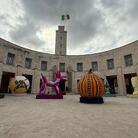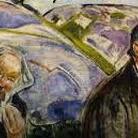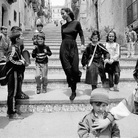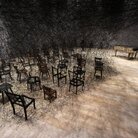Splendida Minima. Piccole sculture preziose nelle collezioni medicee: dalla Tribuna di Francesco I al tesoro granducale

Manifattura italiana, Alessandro Magno e Olimpiade, fine del XVII – prima meta del XVIII secolo (ante 1753), sardonice bianca e bruna. Firenze, Museo Archeologico Nazionale
Dal 21 June 2016 al 2 November 2016
Firenze
Luogo: Tesoro dei Granduchi - Palazzo Pitti
Indirizzo: piazza de' Pitti 1
Curatori: Valentina Conticelli, Riccardo Gennaioli, Fabrizio Paolucci
Enti promotori:
- Ministero dei beni e delle attività culturali e del turismo
- Gallerie degli Uffizi
- Firenze Musei
Sito ufficiale: http://www.gallerieuffizimostre.it
Come recita il suo titolo, questa mostra è dedicata ad una particolare classe di manufatti di grande valore artistico e raffinatezza, sebbene di ridotte dimensioni: piccole sculture a tutto tondo in pietre preziose, di epoca ellenistico romana, per secoli al centro dell'interesse collezionistico dei Medici e oggi in gran parte patrimonio del museo del Tesoro dei Granduchi delle Gallerie degli Uffizi.
L'esposizione "rivela – al pari di una lente metaforica – un universo di piccole magnificenze (...). Eppure, sfogliando il catalogo, non di rado l’occhio si arresta su un’immagine, che a prima vista sembra illustrare una scultura di dimensioni magnifiche, se non addirittura un colosso. Sono effetti ingannevoli: e perciò un ritratto imperiale che appare enorme – ma che in verità misura solo pochi centimetri – fa capire come il grandioso non debba essere necessariamente grande e come la monumentalità non sia sempre legata all’effettivo formato di un’opera"( Eike D. Schmidt, Direttore delle Gallerie degli Uffizi).
La mostra si apre illustrando con alcuni esempi le caratteristiche di questi piccoli formati scultorei di epoca classica, realizzati a tutto tondo da pietre preziose, e mettendo in risalto la loro stupefacente vicinanza, in termini iconografici e formali, con la grande plastica del periodo. E' questo il caso del Ritratto di Augusto del Tesoro dei Granduchi messo a diretto confronto con una replica marmorea dello stesso tipo.
Il corpus complessivo delle preziose sculture antiche ad oggi noto è costituito da circa quattrocentottanta esemplari, un numero senz’altro errato per difetto e destinato quindi a crescere con il progredire degli studi. Nella prima sezione sono anche illustrate le funzioni di queste preziose sculture che, come dimostrano confronti iconografici testimoniati in mostra da un prezioso dittico eburneo del VI secolo d.C. o da un rilievo marmoreo degli inizi del III secolo d. C., erano utilizzate come complementi di attributi connessi con i ritratti legati al culto imperiale.
Una grande passione per questo genere di sculturine in pietre dure fu propria di Francesco I de' Medici, che ne possedeva una nutrita collezione e si impegnava ad incrementarla commissionando la ricerca a Roma di marmi e pietre adatti alla creazione di busti. Teste antiche in pietre dure furono così assemblate su busti in alabastro orientale, scolpiti nelle botteghe di corte e impreziositi da panneggi e acconciature d'argento dorato. Questa collezione fu destinata da Francesco I all'arredo della Tribuna (descritto nell'inventario del 1589), uno scrigno delle meraviglie nel cuore degli Uffizi. Tra queste spiccano in particolar modo il Busto femminile con testa di cristallo di rocca di età imperiale, il Canopo egizio in calcedonio e il Busto di mora in onice e argento dorato dell'intagliatore milanese Giorgio Gaffuri. Le piccole sculturine preziose furono utilizzate anche per abbellire le mensole che reggevano il palchetto della Tribuna: del loro arredo si offrono in mostra due testimonianze esemplificative.
Nel corso del Seicento e del Settecento altri illustri esponenti della dinastia medicea raccolsero e coltivarono il gusto di raccogliere questi particolari oggetti. Tra questi si distinse il Cardinal Leopoldo, raffinato e colto collezionista, che acquistò pezzi d'eccezionale qualità, come la mano in calcedonio che fa da icona alla rassegna.Al merito di Cosimo III si deve in seguito l’inserimento delle opere dello zio Leopoldo nell’arredo sempre più sfarzoso della Tribuna, che ci viene testimoniato al suo acme dai puntuali disegni dell’atlante della Galleria diretto da Benedetto Vincenzo De Greyss. Dalla testimonianza di questo preziosissimo documento nell’ultima sezione della mostra si è tentata la ricostruzione a grandezza naturale dell’allestimento tardo settecentesco di uno dei palchetti della Tribuna degli Uffizi. La scenografica riproduzione del disegno della parete con la statua di Apollo fa da sfondo a quasi tutte le opere distribuite sullo scaffale: le poche mancanze sono dovute a pezzi perduti o di cui non è stato possibile ottenere il prestito in mostra. Si tratta del primo tentativo di ricostruire questo aspetto fondamentale della decorazione della Tribuna, che mette in luce come, ancora nel Settecento, la disposizione delle statue sulla mensola fosse incentrata su sottili rapporti tra le dimensioni e le cromie degli oggetti. La riproposizione dà corpo ai rimandi e alle relazioni che si creavano tra le opere a tutto tondo disposte sulle pareti della Wunderkammer: si recupera così un brano significativo per la ricomposizione di quella ‘musica visiva’ che aveva fatto della Tribuna - e degli oggetti in essa contenuti - l’espressione di un’architettura mentale e di una raffinata quanto complessa veste di rapporti iconografici e simbolici che si va progressivamente svelando.
SCARICA IL COMUNICATO IN PDF
COMMENTI

-
 Dal 28 October 2025 al 15 February 2026
Brescia | Pinacoteca Tosio Martinengo
Dal 28 October 2025 al 15 February 2026
Brescia | Pinacoteca Tosio Martinengo
Peter Paul Rubens. Giovan Carlo Doria a cavallo
-
 Dal 31 October 2025 al 21 March 2026
Rovereto | Mart Rovereto
Dal 31 October 2025 al 21 March 2026
Rovereto | Mart Rovereto
Le sfide del corpo
-
 Dal 31 October 2025 al 15 February 2026
Roma | Museo del Genio
Dal 31 October 2025 al 15 February 2026
Roma | Museo del Genio
Vivian Maier. The exhibition / Pop Air. Ugo Nespolo
-
 Dal 30 October 2025 al 1 March 2026
Venezia | Centro Culturale Candiani
Dal 30 October 2025 al 1 March 2026
Venezia | Centro Culturale Candiani
Munch e la rivoluzione espressionista
-
 Dal 24 October 2025 al 1 March 2026
Saluzzo | La Castiglia
Dal 24 October 2025 al 1 March 2026
Saluzzo | La Castiglia
Ferdinando Scianna. La moda, la vita
-
 Dal 22 October 2025 al 28 June 2026
Torino | MAO – Museo d'Arte Orientale
Dal 22 October 2025 al 28 June 2026
Torino | MAO – Museo d'Arte Orientale
Chiharu Shiota. The Soul Trembles


